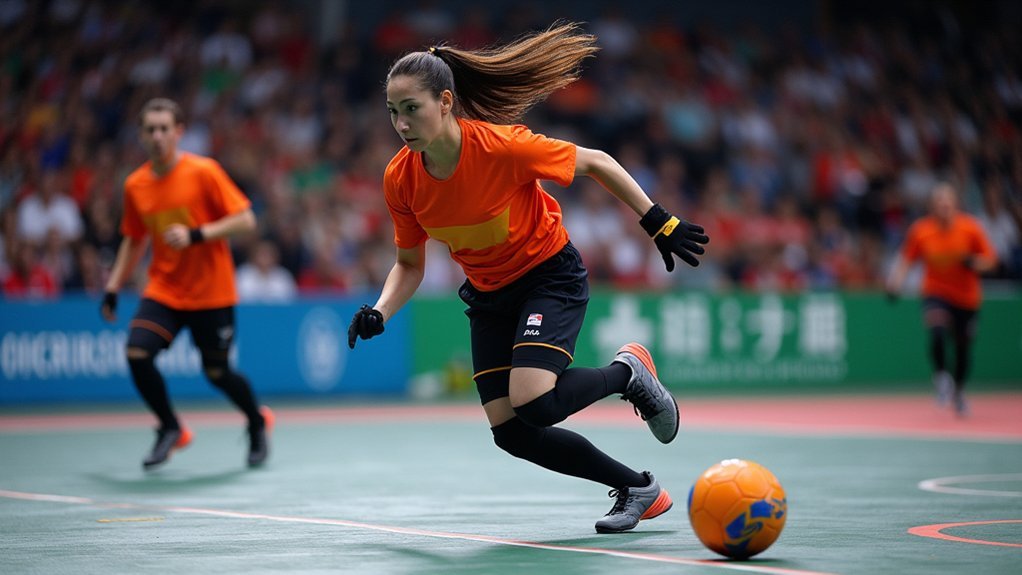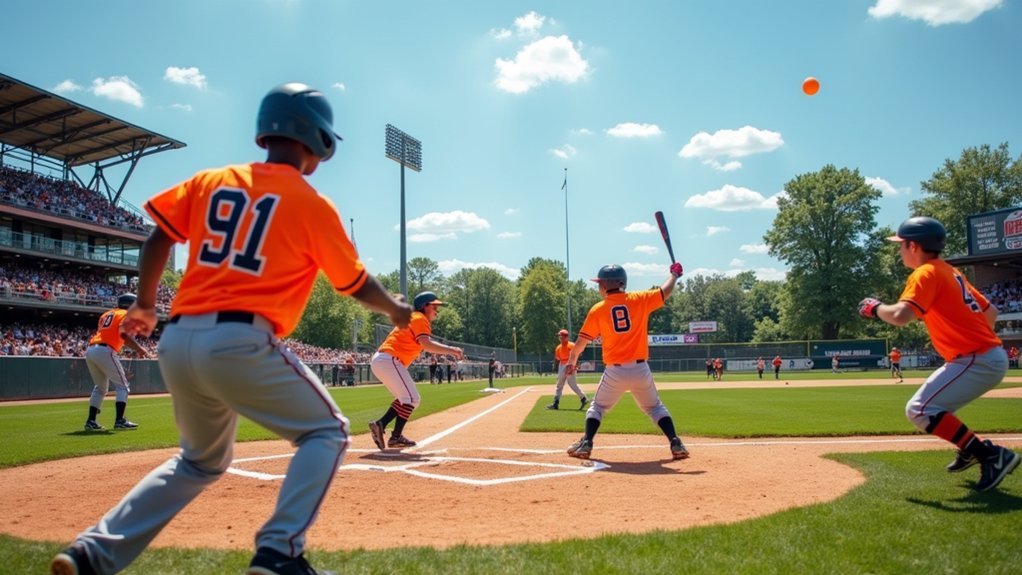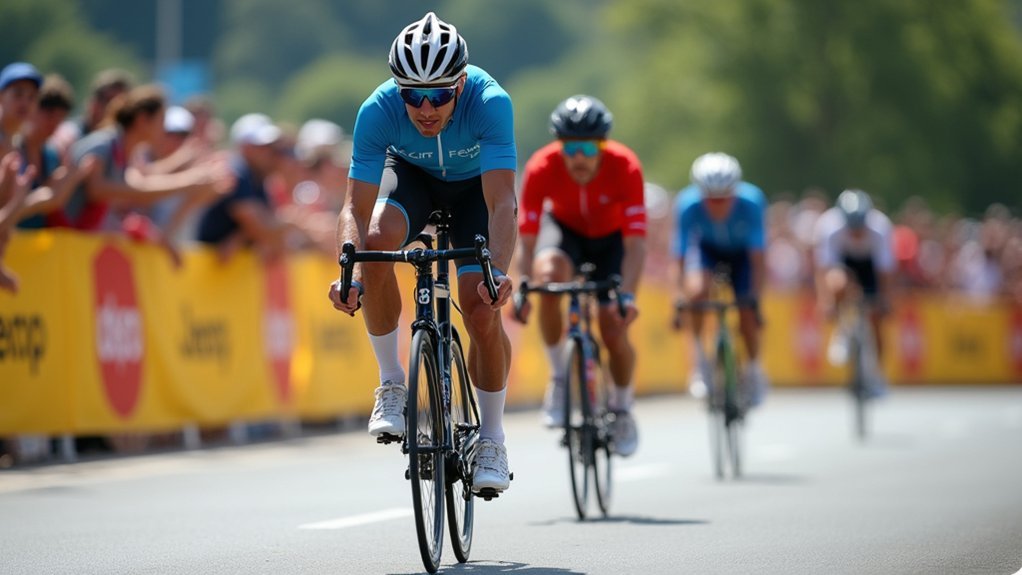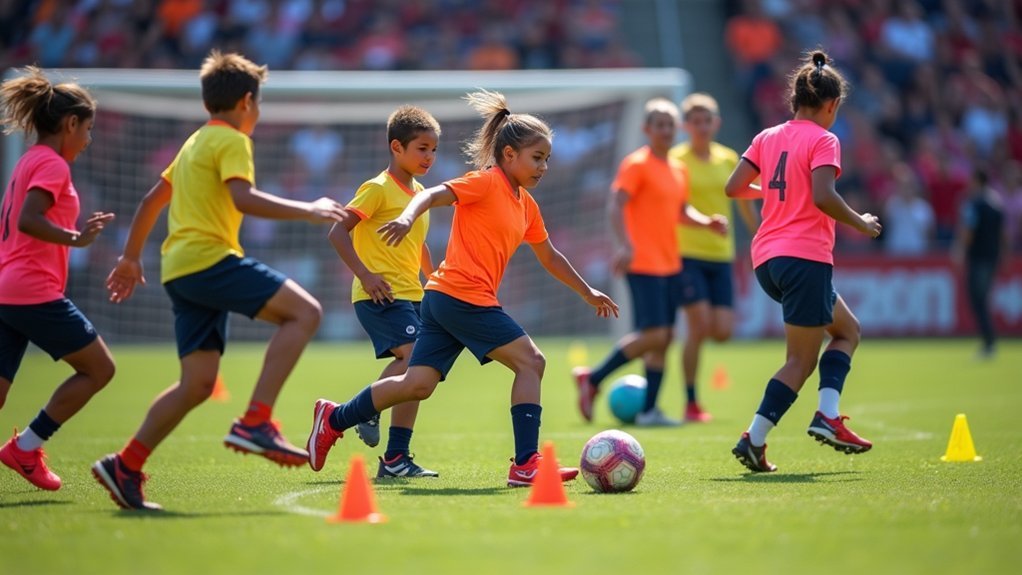Visually impaired athletes can excel in five specially adapted team sports: Goalball, where players track a bell-containing ball; Blind Soccer, featuring an audible ball on enclosed fields; Beep Baseball, using sound-emitting equipment; Blind Cricket, with auditory adaptations of the traditional game; and Tandem Cycling, pairing sighted and visually impaired cyclists for synchronized racing. Each sport emphasizes sound tracking, teamwork, and specialized rules that showcase athletes’ abilities beyond vision. Discover how these competitive opportunities create inclusive sporting communities worldwide.
Goalball: The Paralympic Sport Designed Specifically for Blind Athletes

While many sports have been adapted for visually impaired athletes, goalball stands apart as a sport created exclusively for those with vision loss. Developed in 1946 as rehabilitation for veterans, this dynamic team sport has evolved into a Paralympic Games staple.
Goalball uniquely serves athletes with vision loss, transforming from post-war rehabilitation into Paralympic prominence.
In goalball, two teams of three players compete on a rectangular court using a ball containing bells for sound orientation. All players wear eye masks to guarantee equal conditions regardless of vision level. They rely entirely on hearing to track the jingling ball across the court.
Matches consist of two 12-minute halves where players use their bodies to block shots and must bounce the ball twice in the opposing area to score.
Unlike most sports, spectators must remain silent so blind athletes can hear the ball’s movement.
Blind Soccer: Fast-Paced Teamwork With Sound-Enhanced Balls
Unlike goalball, blind soccer adapts the world’s most popular sport for visually impaired athletes through innovative modifications. You’ll find teams of four blind players plus one sighted goalkeeper competing on enclosed, smaller fields that keep the action fast-paced.
The key to this dynamic sport is the audible ball, which emits noise so players can track its location as they navigate the field. Coaches provide verbal guidance during matches, enabling effective communication and strategic play.
| Feature | Benefit | Experience |
|---|---|---|
| Audible ball | Location tracking | Enhanced spatial awareness |
| Enclosed field | Continuous play | Fast-paced action |
| Verbal coaching | Strategic guidance | Improved teamwork |
| IBSA championships | International competition | Global community |
The International Blind Sports Association hosts championships worldwide, creating competitive opportunities for visually impaired athletes passionate about soccer.
Beep Baseball: America’s Favorite Pastime Reimagined for the Visually Impaired

The crack of the bat takes on new meaning in beep baseball, where sound becomes the primary guide for visually impaired athletes. This adaptive sport pairs sighted pitchers and catchers with blindfolded players who track a beeping ball and bases that buzz when activated.
The National Beep Baseball Association organizes competitive play nationwide, creating an inclusive community where teams of 10 players showcase remarkable skills.
You’ll find this sport particularly accessible because:
- Sound-emitting equipment guides players through gameplay
- Teams include players with varying levels of visual impairment
- All fielders wear blindfolds to guarantee equal challenge
- Specialized rules promote independence and athletic achievement
Beep baseball delivers America’s favorite pastime in a format that emphasizes teamwork, physical fitness, and competitive spirit for visually impaired players.
Blind Cricket: a Global Team Sport With Tactile and Auditory Adaptations
Millions of cricket enthusiasts worldwide have embraced blind cricket, a dynamic adaptation that transforms the traditional sport through innovative auditory elements. Players track the specialized ball containing bells by sound rather than sight, allowing visually impaired athletes to participate fully in the game.
You’ll find teams typically consist of 11 players, including both blind and partially sighted individuals who compete together under adapted rules. To maintain fairness, participants wear eyepatches or blindfolds based on their visual classification.
The World Blind Cricket Council governs this growing sport, organizing international competitions that showcase top teams from cricket-loving nations like India, Australia, and England.
The auditory adaptations don’t change cricket’s core spirit—they simply open the beloved game to a wider community of passionate players.
Tandem Cycling: Partnership-Based Competitive Racing for Visually Impaired Athletes

Tandem cycling redefines team sports through a unique partnership that pairs sighted and visually impaired athletes on a single bicycle. This dynamic activity has gained popularity since its inclusion in the Commonwealth Games, offering a competitive racing opportunity that showcases remarkable teamwork.
The tandem partnership divides responsibilities strategically:
Purposeful division of roles creates the perfect balance between pilot and stoker in tandem cycling.
- The sighted pilot handles steering and balance
- The visually impaired stoker focuses on pedaling power
- Both cyclists maintain synchronized rhythm
- Communication becomes essential for peak performance
You’ll find support through organizations like The Tandem Club, which connects visually impaired athletes with local resources.
Community engagement thrives as these clubs foster both recreational and competitive opportunities. If you’re looking for a sport that combines physical fitness with genuine partnership, tandem cycling delivers an accessible and exciting experience.
Frequently Asked Questions
What Is the Best Sport for Visually Impaired?
Goalball is your best choice as it’s specifically designed for visually impaired athletes. You’ll play with teams of three, using a ball containing bells that helps you orient yourself through sound.
What Is the Team Sport for Blind Athletes?
Goalball is the premier team sport for blind athletes. You’ll wear eyeshades and use your hearing to track a bell-filled ball while playing in teams of three to score goals against opponents.
What Sports Can You Play With Bad Eyesight?
With bad eyesight, you can enjoy goalball, beep baseball, blind soccer, judo, and wrestling. You’ll find adapted versions of basketball and football too. These sports use sound cues or minimal visual requirements for participation.
What Sport Is Unique to the Visually Impaired?
Goalball is uniquely designed for visually impaired athletes. You’ll play with a ball containing bells, wearing eyeshades to guarantee fairness. It’s a Paralympic sport where you’ll rely entirely on your hearing to compete effectively.
In Summary
You don’t need to limit yourself when it comes to team sports, regardless of visual impairment. From goalball to tandem cycling, these adapted sports offer incredible opportunities to compete, build friendships, and stay active. Whether you’re drawn to the strategy of cricket or the excitement of beep baseball, there’s a team sport waiting for you. Explore these options and discover which one ignites your competitive spirit!





Leave a Reply